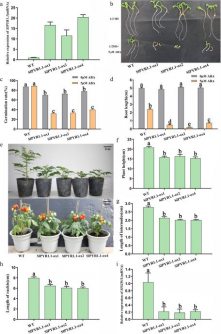Tomato Study Uncovers Key Hormone’s Role in Growth and Color

Research conducted by a team from Chongqing University of Arts and Sciences has shed light on the significant roles of abscisic acid (ABA) receptors in tomatoes, particularly how they influence growth, aging, and fruit coloration. Published in the journal Plant Hormones on July 8, 2025, the study reveals that overexpressing these receptors leads to a range of physiological changes, including dwarfism, delayed leaf aging, and enhanced fruit pigmentation.
Abscisic acid is a crucial hormone that regulates plant development and responses to environmental stress. While previous studies have focused on its role in fruit ripening and stress response, the mechanisms by which ABA affects vegetative growth and flower development were not fully understood. The research focused on the PYR/PYL/RCAR receptor family, which acts as molecular switches to activate downstream signaling pathways.
In their investigation, the researchers identified 15 members of the SlPYR/PYL receptor family in the tomato genome. These genes were classified into three subfamilies that correspond to their homologs in the model plant Arabidopsis. The study found that two specific receptors, SlPYR1.1 and SlPYL8.1, showed significant responsiveness to ABA, salt, and ethylene, indicating their important roles in various plant functions.
The research team utilized transcriptomic datasets and expression profiling to explore the response of these receptors under different hormonal treatments. They noted that SlPYR1.1 was associated with ABA hypersensitivity, resulting in reduced germination rates and shorter roots. This suggests a potential antagonistic relationship between ABA and gibberellin pathways, as evidenced by the downregulation of SlGID1, a key gibberellin receptor.
In contrast, overexpression of SlPYL8.1 led to delayed senescence of leaves, characterized by their dark green color and increased chlorophyll and carotenoid levels, indicating enhanced mesophyll cell proliferation. However, this overexpression also resulted in reproductive anomalies, such as floral bud abortion and changes in flower orientation, highlighting the trade-offs involved in hormonal regulation.
Remarkably, tomatoes with elevated SlPYL8.1 expression exhibited increased levels of lycopene, the compound responsible for the fruit’s red color. This suggests that this receptor not only plays a role in stress response and growth regulation but also significantly impacts fruit coloration and ripening.
The findings from this study indicate that both SlPYR1.1 and SlPYL8.1 are critical for linking ABA signaling to developmental and stress-related responses in tomatoes. By manipulating their expression, researchers believe they can enhance desirable agricultural traits, including improved stress resilience, delayed leaf aging, and better fruit color, without compromising overall plant health.
The ability of SlPYL8.1 to enhance lycopene accumulation presents a promising avenue for improving the nutritional quality and shelf life of tomatoes. Additionally, understanding the mechanisms of reproductive inhibition mediated by these receptors may inform breeding strategies aimed at minimizing yield loss.
Overall, this research contributes to a deeper understanding of how ABA signaling operates within tomatoes, offering essential insights for crop improvement in environments prone to stress. The study was supported by the Chongqing Natural Science Foundation and highlights the potential for hormone engineering to optimize growth-defense trade-offs in horticultural crops.






